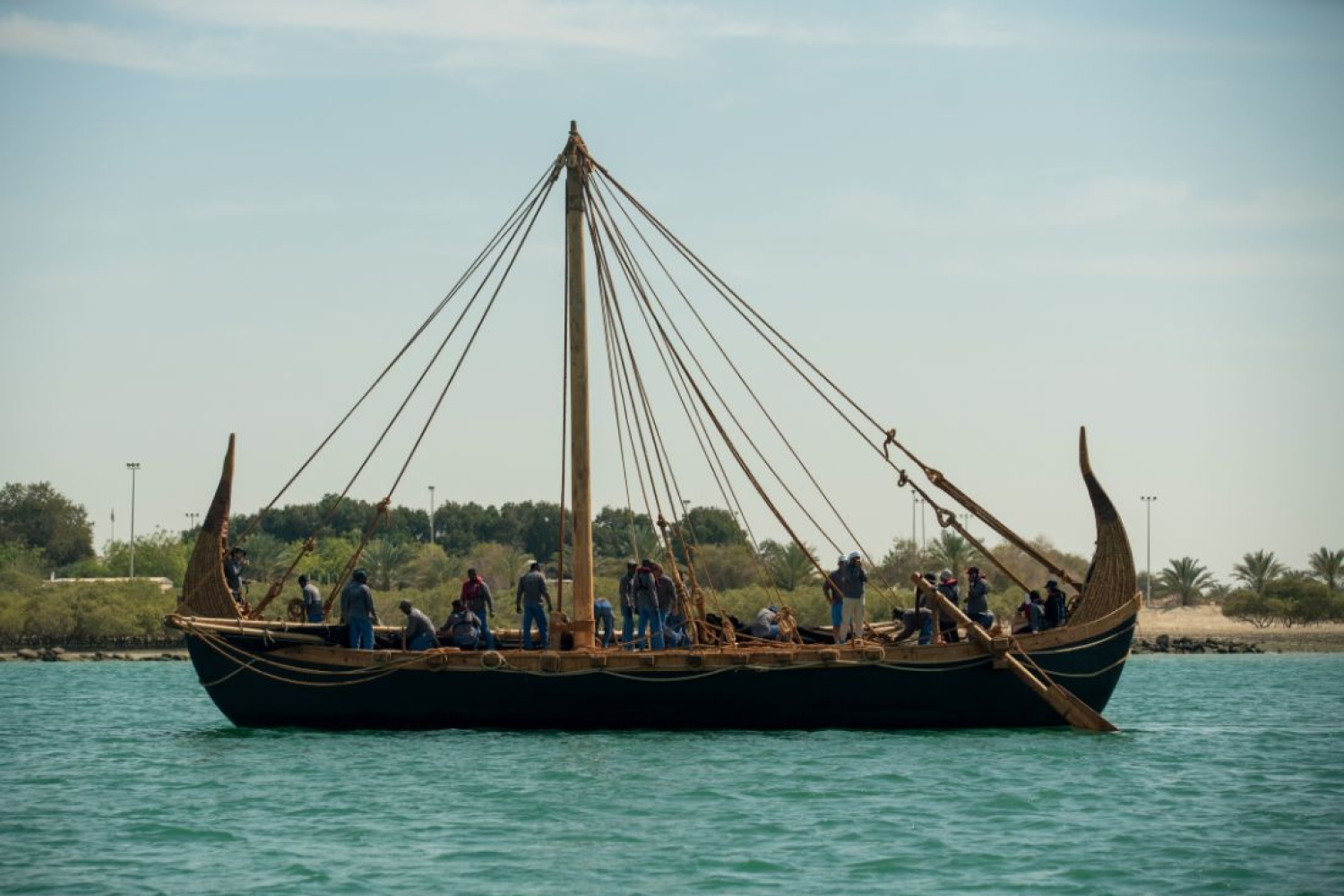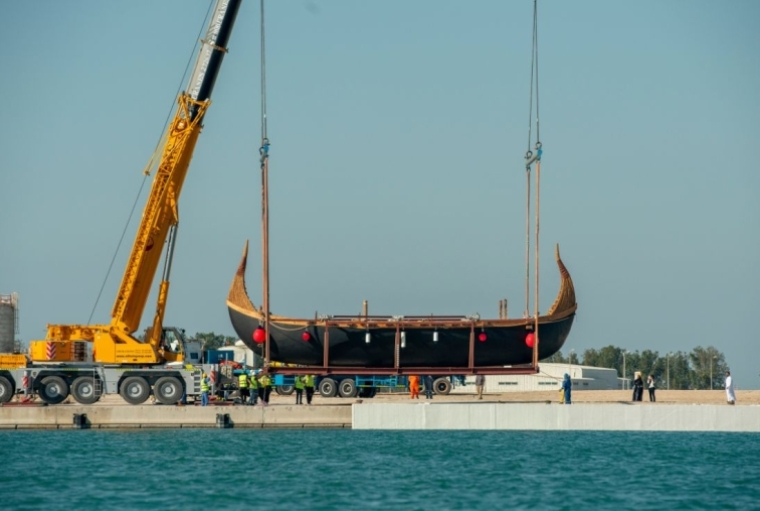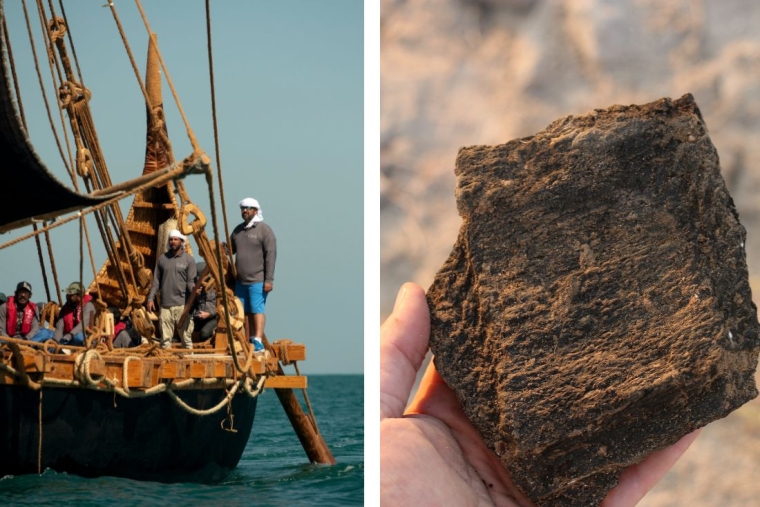

The world’s largest reconstruction of a Magan Boat from the Bronze Age period has successfully sailed off the coast of Abu Dhabi. The maiden voyage of the 18-metre-long vessel marks a major milestone in the research programme of Zayed National Museum, the new national museum of the United Arab Emirates, currently under construction on Saadiyat Island.
The reconstruction of the boat, using materials described on an ancient clay tablet and techniques dating back to 2100 BCE, is part of a research collaboration between Zayed National Museum, New York University Abu Dhabi (NYU Abu Dhabi) and Zayed University.
The research project serves to deepen understanding of how Bronze Age societies lived and uncover secrets of traditional craftsmanship which helped create connections between the UAE and the rest of the world.

is Excellency Mohamed Khalifa Al Mubarak, Chairman of the Department of Culture and Tourism – Abu Dhabi, said: “Appreciating the maritime history of the Arabian Gulf is key to understanding trade and cultural connections in the wider ancient world, which is an important focus for Zayed National Museum. From ancient shipbuilders to today’s archaeologists, the launch of this impressive Magan boat reconstruction represents thousands of years of Emirati invention and exploration. Just as these ships connected ancient communities, this project has brought together specialists from Abu Dhabi and beyond to deepen our knowledge of the past and bring history to life.”
The vessel was known in ancient times as a ‘Magan Boat’. Magan was the ancient name for the region known today as the UAE and Oman, highlighting the area’s reputation for maritime trade as far back as 4,000 years ago. Ships of this size and strength revolutionised trade between Magan and communities in Mesopotamia (modern-day Iraq) and the Indus Valley (modern-day Pakistan and India), allowing the passage of goods such as copper, semi-precious stones and textiles.
The boat passed several rigorous tests and covered a distance of 50 nautical miles (92.6km) in the Arabian Gulf. Captained by Emirati sailors, the ship passed two days of sea trials, reaching speeds of up to 5.6 knots under a sail made of goat hair.
The project brought together an international team of over 20 specialists from five countries, including curators, professors, archaeologists, students from the UAE, shipwrights from Kerala and other specialists from Italy, USA and the UK. The shape of the vessel was based on ancient illustrations of boats and the reconstruction was based on a capacity of 120 Gur which is equivalent to 36 tons. A crew of more than 20 people was needed to lift the sail and rigging as pulleys did not exist in the Bronze Age.
Shipwrights specialising in historical replicas worked with the researchers to build the boat using raw materials and traditional hand tools. The outer hull of the ship was made from 15 tons of locally sourced reeds that were soaked, stripped of their leaves, crushed and tied into long bundles using date palm fibre rope. The reed bundles were lashed to an internal structure of wood frames and coated in bitumen – a waterproofing technique used by ancient ship makers in the region. Archaeologists have recently discovered similar examples of bitumen on the island of Umm an-Nar which match sources from Mesopotamia.
Dr. Peter Magee, Director of Zayed National Museum, said: “It has been a long and exciting journey from discovering ancient fragments of Magan boats on the island of Umm an-Nar to the iconic moment the boat’s goat hair sail was raised and she set sail from the coast of Abu Dhabi, traversing the same route these monumental vessels would have travelled 4,000 years ago towards the open sea and the coastline of India.”
Champion Emirati sailor Marwan Abdullah Al-Marzouqi, who comes from a family whose links with the maritime heritage of the UAE go back generations, was one of two captains who skippered the Magan Boat during its two days of sea trials.
“When we first towed the boat out from the jetty, we were very careful. I was very aware it was made from only reeds, ropes and wood — there are no nails, no screws, no metal at all — and I was afraid of damaging her. But as we got under way, I soon realised that this was a strong boat. I was surprised by how this big boat, weighed down with a heavy ballast, moved so smoothly on the sea”.
He added that the making of the boat highlights “the golden history of Magan, which actually is the foundation of the country we have today and is something of which we should all be aware and proud of.”

The ‘Magan Boat’ project is an experimental archaeology initiative from Zayed National Museum in partnership with Zayed University and New York University Abu Dhabi (NYU Abu Dhabi). Launched in 2021, the project aims to deepen understanding of how people in the region lived over 4,000 years ago, as well as preserving the UAE’s maritime heritage and traditional crafts. Specialists from several disciplines – including archaeology, anthropology, digital humanities, engineering, and science – came together to design and construct the ship.
Visitors will see the Magan Boat on display when Zayed National Museum opens. Zayed National Museum celebrates the UAE’s rich, long history and culture from the ancient past to the modern day. As a research institution, the museum is a driving force for developing, promoting, and coordinating archaeological and heritage research in the UAE.
The boat construction is part of a broader initiative that seeks to understand Abu Dhabi’s role in Bronze Age trade. Umm an-Nar Island, located off the coast of Abu Dhabi city, was once one of the region’s largest ancient ports. Recent discoveries by archaeologists from the Department of Culture and Tourism – Abu Dhabi indicate that Umm an-Nar had significant international importance in the Bronze Age. Discoveries include a number of buildings containing grinding stones, polished stones, stone axes, copper fishhooks, and pierced circular stone disks, used to weigh down fishing nets. Many pottery vessels were found to have been imported from as far away as ancient Mesopotamia and south Asia, emphasising the island’s pivotal role in long-distance trade.
Words Platform Desk
Date 12.10.2024